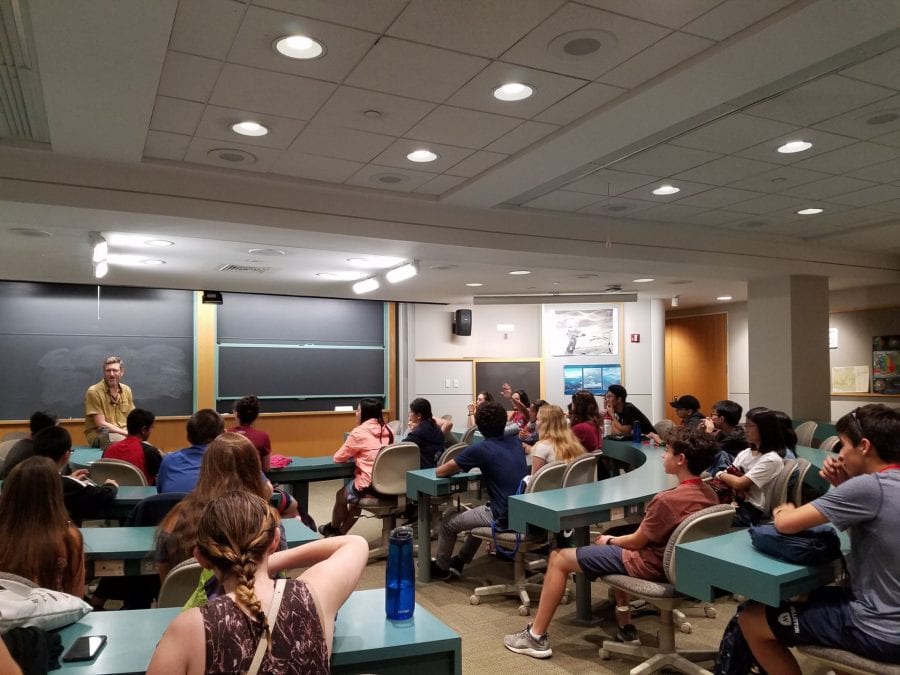Summer@Brown is the largest of our Pre-College Programs, and attracts nearly 4,000 exceptionally high-achieving and motivated students each summer. They enroll in one or more of the 200+ courses, which are designed and taught at the level of first-year college courses, and ranging in length from one to four weeks. As a distinctively Brown University program, resting on the principles that are at the core of a Brown undergraduate liberal arts education and its open curriculum, the Pre-College Programs aim to shift student focus away from formal grades and credits and, by creating student-centered learning experiences, towards the learning itself. Coupled with an experience of independent living on a university campus alongside a diverse group of otherwise like-minded peers, Summer@Brown is designed to acquaint students with the social and personal demands they will encounter as first year students at a selective college or university.
The course in which a student is enrolled stands, naturally, at the center of their experience. Though they are high school students, they arrive at a program exceptionally well prepared. Indeed, because the students have chosen their classes freely, they are committed to the material in a very real way. As instructors, your contribution to the success of their experience is obviously crucial – and the most successful experience is one in which the student is engaged and challenged. Instructors can ask and expect them to perform as first year college students, and the students themselves expect this. In their reviews of their experience at Brown, they frequently express their appreciation and gratitude to instructors who treat them like adults; who listen to, and value, what they and their peers have to say; and who challenge them to think deeper and harder – and in the process indicate the degree to which they respect their students as independent thinkers and learners. Naturally, not all students will be capable of achieving full mastery equivalent to undergraduates – and this is as it should be. The program is not designed to bring student to mastery in all cases. This is why the courses are both non-credit and “graded’ only on a pass/fail basis. The intent, rather, is to provide students a realistic sense of what the demands of college level learning are, notwithstanding how close or far they may be from that.
With very few exceptions, your course is the only course in which a student is enrolled in a given term, and you can therefore expect them to engage in outside work approximately two to three hours daily, per class day. Longer projects may be required for courses spanning weekends. Depending on the subject matter, such outside work can take a wide variety of forms (i.e., reading and writing, individual study, group work and projects). While the program does provide numerous educational and social events throughout students’ time here, the course should be the central element of their focus. Students are more than willing to engage in a variety of out-of-class activities – particularly those that enable them to engage with the other students in the course – and expect that they will be required to do far more than merely attend the class.
While we have noted that the course a student enrolls in stands at the center of their experience at Brown, the fact is that a significant motivation for them to be here is to be with other like-minded students. In their classes at their home high schools, many of our students find themselves alone in their fascination with a particular subject matter, and what they seek at Brown is not just an instructor who will treat them as a serious student, but also a community of others like them, just as deeply interested in a subject matter as they are. Who else is in the classroom matters a great deal to them, and as an instructor, it is crucial that you be aware that they will be looking to learn from each other as much as to learn from you, and that you take advantage of this as an opportunity for deeper learning experiences for all your students.
Additionally, because the courses you teach are intensive and fast-paced – classes meet three hours daily, five days week – your syllabus and how you teach need to be adjusted to that context. To keep the forward momentum moving at an accelerated pace, students need a syllabus that guides them clearly and efficiently through each day, with work outside of class seamlessly integrated into the work done in the class. And what happens in the class needs to be designed to keep them engaged actively, so that they spend little time as passive learners. This means not only that traditional lecturing needs to be kept to a minimum, but also that students have multiple and varied opportunities to engage as active learners and that they engage with each other in that process as well as interacting with you, the instructor.
Teaching in Summer@Brown program provides advanced Graduate Students and Post-Docs with exceptional preparation not only for a future career in teaching but for any work that involves communicating knowledge to others and working with groups.


